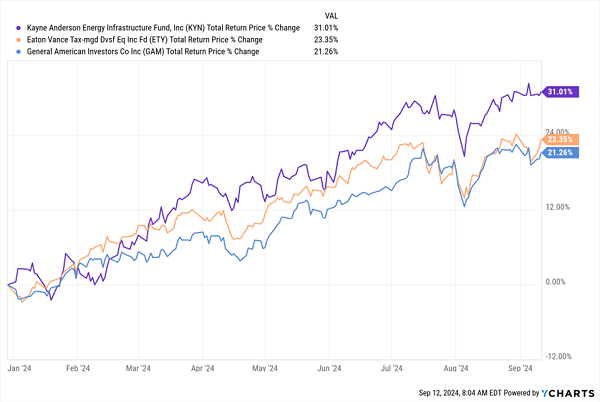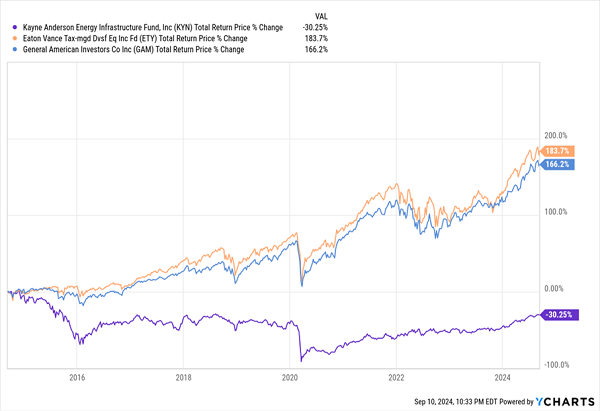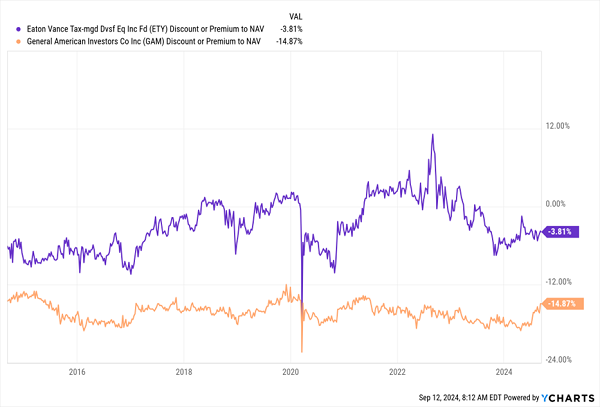Sometimes as income investors we face a situation that sounds like a good problem to have: We have to pick among a group of very impressive investments!
That’s obviously much tougher than, say, picking between a stock or fund with a winning record and another with a losing one.
But when you think about the investment choices you’ve made over the years, I think you’ll find that picking between options that seem equally good is actually what you’ve had to do most of the time.
To get into how to make a call when you face this situation, we’re going to use my favorite high-income plays: closed-end funds (CEFs), which routinely yield 8%+.
That way I can show you what I do to come to that perfect (or as close to perfect as possible!) mix of high, safe dividends, potential upside and overall investment quality.
On the surface, the three funds we’ll look at below will all look great to many income investors. Here’s why:
- Each has a huge yield, ranging from 5.2% to 8.4% as I write this.
- Each has tremendous returns, up over 20% year to date.
- Each trades at a discount to its portfolio value (a “discount to NAV,” or net asset value, in CEF-speak).
- Each trades on the open market, so it can be bought and sold like a regular stock.
- Each is professionally managed.
Granted, these features all sound perfect, so you could be forgiven if your first instinct is to just buy all three of these funds. But if we dig into the details, we find that there is, in fact, a clear winner here.
Our 3 CEF “All-Stars”
Our three CEFs boast the strongest performance in the space this year. They are: the Kayne Anderson Energy Infrastructure Fund (KYN), Eaton Vance Tax-Managed Diversified Equity Fund (ETY) and General American Investors Co. (GAM).
As you can see below, they’ve absolutely soared since January 1:
Big, Fast Returns From Our “Power Trio”

And when we dig into their stats, we see they have what it takes to back up that run:

As you can see, each fund offers a big yield and a steep discount (except ETY, though its 3.8% discount is still pretty respectable). And look at the “yield on NAV” column. That’s the yield as calculated on the fund’s NAV, not the discounted market price.
That’s part of the magic of CEFs: The yield on NAV is lower than the yield on market price (or the yield we get, in other words), making the payout easier for management to cover.
All right, this all sounds good so far. But we’re no closer to making our choice.
Well, maybe we are, actually, because if we zoom out to the past decade, we see that one fund of these three is a clear winner on the performance side of things.
A Big Divergence Appears

While ETY and GAM have posted strong total returns, up 184% and 166%, respectively, KYN is down a lot. So despite the strong return KYN posted this year, this fund is not a long-term hold.
That makes sense: KYN holds oil and energy-related infrastructure firms, and energy is a cyclical industry that rises and falls with volatile oil and gas prices.
So KYN makes sense if you’re bullish on oil, which was a good place to be at the start of 2024, with oil rising throughout the year, defying expectations. But the trick with this fund is that you’ll need to sell (and likely quickly) when expectations for oil get too hot.
That makes KYN a good short-term play that gets you a nice 8.2% dividend yield as you wait for oil to reach the price you expect it to get to.
At my CEF Insider service, however, we focus on holding funds for the long term, so we can collect their income over years instead of weeks or months. And that’s why ETY and GAM, despite the former’s smaller discount and the latter’s smaller yield, make more sense for us.
So we’re down to two funds. But which is worth buying now? Again, going by a quick glance, GAM’s bigger discount makes it look more appealing. But look at this chart:
Are Bigger Discounts Really Better?

We see that GAM’s 14.9% discount (the orange line) is actually smaller than the 16.3% it’s averaged over the last decade, so it isn’t as much of a deal as it appears to be. In fact, GAM could see price declines as its discount reverts to the average.
What’s more, as you can see in the purple line above, ETY trades at premiums every so often, making its relatively humble 3.8% discount look better. That’s especially true since ETY has slightly outperformed GAM over the last decade, with that 184% to 166% total return we saw earlier.
Plus, ETY yields more! With an 8.4% yield on market price, it’s actually the most generous of these three funds.
However, there is one thing we need to keep in mind: ETY invests in a lot of household-name large-cap stocks like Microsoft (MSFT), Apple (AAPL), and Walmart (WMT), then writes call options on those stocks to generate income it uses to help fund its payout.
That strategy does tend to slow overall returns, as a fund’s best performers get sold or “called away.” But management has successfully navigated that, throttling its call-option sales in a timely way to minimize that drag. The result: that 184% total return over the last decade—and that superior 8.4% dividend, too.
Taken together, ETY has a well-rounded collection of strengths that put it above GAM and KYN. And there are plenty of other CEFs out there that do, too, paying outsized dividends—the average yield across CEFs is 8.2%—and even paying us every month instead of every quarter, like the typical S&P 500 stock.
The “Unstoppable” 10.5% Dividends (Paid Monthly) You MUST Buy as Rates Fall
Look, I think it’s safe to say this now (finally!): We’ve got interest rate cuts on the way.
There’s no longer any question. When the Fed meets later this week, it’ll likely drop the first of a string of cuts.
As more cuts roll down the pipe, we can count on one thing: Investors in Treasuries, CDs and other guaranteed investments will scramble for higher yields as those assets yield less and less over the coming years.
How do I know? Because they always do it when rates drop! It never fails.
Funds like the three we just discussed will be winners. But they’re just the start.
To take full advantage of the rate-driven tidal wave of investors set to flow into high-yield CEFs, we want to “lock in” safe dividends even higher than ETY’s 8.4% payout.
The best way to do that? Buy CEFs that pay dividends monthly.
There’s just no better sign of quality than a monthly payout. No way a management team would offer one if they weren’t confident they could keep the payout coming—or even raise it.
I’ve zeroed in on 5 monthly dividend CEFs kicking out a massive 10.5% yield between them. I see them leading the market higher as rate cuts kick in.
The time to buy these 5 smartly run income plays is NOW. Click here to learn about them and to get a free Special Report revealing their names and tickers.
Before you make your next trade, you'll want to hear this.
MarketBeat keeps track of Wall Street's top-rated and best performing research analysts and the stocks they recommend to their clients on a daily basis.
Our team has identified the five stocks that top analysts are quietly whispering to their clients to buy now before the broader market catches on... and none of the big name stocks were on the list.
They believe these five stocks are the five best companies for investors to buy now...
See The Five Stocks Here
Looking to profit from the electric vehicle mega-trend? Enter your email address and we'll send you our list of which EV stocks show the most long-term potential.
Get This Free Report